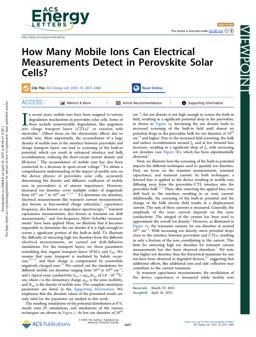2025-04-24
How Many Mobile Ions Can Electrical Measurements Detect in Perovskite Solar Cells?
Publication
Publication
ACS Energy Lett. , Volume 10 - Issue 5 p. 2457- 2460
In recent years, mobile ions have been assigned to various degradation mechanisms in perovskite solar cells. Some of these include nonreversible degradation, like migration into charge transport layers (CTLs) (1) or reaction with electrodes. (2) Others focus on the electrostatic effects due to mobile ions. Most importantly, the accumulation of a large density of mobile ions at the interface between perovskite and charge transport layers can lead to screening of the built-in potential, which can result in enhanced interface and bulk recombination, reducing the short-circuit current density and fill-factor. (3) The accumulation of mobile ions has also been connected to a decrease in open-circuit voltage. (4) To obtain a comprehensive understanding of the impact of mobile ions on the device physics of perovskite solar cells, accurately determining the density and diffusion coefficient of mobile ions in perovskites is of utmost importance. However, measured ion densities cover multiple orders of magnitude from 1015 cm–3 to 1019 cm–3. (3,5−7) To determine ion densities, electrical measurements like transient current measurements, also known as bias-assisted charge extraction, (3) capacitance frequency, also known as impedance spectroscopy, (8,9) transient capacitance measurements, also known as transient ion drift measurements, (9) and low-frequency Mott–Schottky measurements (5) have been applied. Here, we illustrate that it becomes impossible to determine the ion density if it is high enough to screen a significant portion of the built-in field. To illustrate the difficulty of extracting high ion densities from the different electrical measurements, we carried out drift-diffusion simulations. For the transport layers, we chose parameters resembling thin organic transport layers 2PACz and C60. We assume that ionic transport is mediated by halide vacancies, (10−12) and their charge is compensated by nonmobile negatively charged ions. (13) We carried out the simulations for different mobile ion densities ranging from 1016 to 1020 cm–3, and a typical ionic conductivity σion = eμionNion of 1.6 · 10–10S/cm, where e is the elementary charge, μion is the ionic mobility, and Nion is the density of mobile ions. The complete simulation parameters are listed in the Supporting Information. We emphasize that the absolute values of the presented results are only valid for the parameter set studied in this work.
| Additional Metadata | |
|---|---|
| ACS | |
| European Research Council (ERC) , Netherlands Organisation for Scientific Research (NWO) | |
| doi.org/10.1021/acsenergylett.5c00887 | |
| ACS Energy Lett. | |
| Organisation | Hybrid Solar Cells |
|
Schmidt, M., & Ehrler, B. (2025). How Many Mobile Ions Can Electrical Measurements Detect in Perovskite Solar Cells?. ACS Energy Lett., 10(5), 2457–2460. doi:10.1021/acsenergylett.5c00887 |
|
